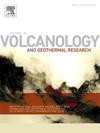Seabed stability inferred from the 2019–2020 earthquake swarm under a volcanic cone field and slopes of Condor Seamount, Azores
IF 2.4
3区 地球科学
Q2 GEOSCIENCES, MULTIDISCIPLINARY
Journal of Volcanology and Geothermal Research
Pub Date : 2025-01-27
DOI:10.1016/j.jvolgeores.2025.108279
引用次数: 0
Abstract
Knowledge of the strength of submarine volcaniclastic deposits is important for assessing the stability of slopes of such materials and their geohazards but is difficult to measure. An opportunity for an alternative evaluation has been presented by an earthquake swarm under a volcanic seamount in the Azores. Attenuation relationships applied to earthquake data suggest that a cone field and flanks of the seamount experienced horizontal accelerations of >0.3 g during the swarm. However, multibeam sonar data collected before and after the swarm suggest that no slope failures occurred. Furthermore, in backscatter data collected after the swarm, low intensities below slopes suggest that muddy aprons were undisturbed by landslide debris. The swarm overlies cones with slopes near typical repose angles of non-cohesive particles. During earthquake shaking, the direction of maximum acceleration deviates from that due to gravity alone. We show that cone slopes effectively experienced much steeper gradients than their repose angles during the swarm. As they survived the shaking without failing, they were effectively stronger than non-cohesive sediment. We use a pseudo-static analysis to investigate the implied sediment strength, finding a ratio of undrained shear strength to vertical stress of >0.4–0.5. This implies shear strength of >24–30 kPa at 10 m depth below seabed. We speculate that carbonate cements and/or compaction may be responsible. If shallow areas are more widely strengthened, slope failure may then be less likely during moderate (ML ∼ 4.0 or less) seismic shaking and hence be less hazardous than if the slopes comprised wholly non-cohesive materials.
从亚速尔群岛秃鹰海山火山锥场和斜坡下的2019-2020年地震群推断的海底稳定性
海底火山碎屑沉积物强度的知识对于评估这些物质的斜坡稳定性及其地质灾害是重要的,但很难测量。亚速尔群岛火山海底山下的地震群为另一种评估提供了机会。地震资料的衰减关系表明,在地震群期间,海山的锥场和侧翼经历了0.3 g的水平加速度。然而,在蜂群之前和之后收集的多波束声纳数据表明,没有发生边坡破坏。此外,在蜂群之后收集的后向散射数据中,斜坡下的低强度表明泥泞的围裙没有受到滑坡碎片的干扰。蜂群覆盖在锥体上,锥体的坡度接近非粘性颗粒的典型休止角。在地震中,由于重力的作用,最大加速度偏离了方向。我们发现,在蜂群中,锥体斜坡有效地经历了比它们的休止角更陡峭的梯度。由于它们在震动中安然无恙,因此实际上比非粘性沉积物更坚固。我们使用拟静力分析来研究隐含的沉积物强度,发现不排水剪切强度与垂直应力的比值为0.4-0.5。这意味着海底以下10 m处的抗剪强度为24-30 kPa。我们推测碳酸盐胶结物和/或压实可能是原因。如果浅层区域得到更广泛的加固,那么在中度(ML ~ 4.0或更小)地震震动期间,边坡破坏的可能性就会更小,因此比边坡完全由非粘性材料组成的危险性更小。
本文章由计算机程序翻译,如有差异,请以英文原文为准。
求助全文
约1分钟内获得全文
求助全文
来源期刊
CiteScore
5.90
自引率
13.80%
发文量
183
审稿时长
19.7 weeks
期刊介绍:
An international research journal with focus on volcanic and geothermal processes and their impact on the environment and society.
Submission of papers covering the following aspects of volcanology and geothermal research are encouraged:
(1) Geological aspects of volcanic systems: volcano stratigraphy, structure and tectonic influence; eruptive history; evolution of volcanic landforms; eruption style and progress; dispersal patterns of lava and ash; analysis of real-time eruption observations.
(2) Geochemical and petrological aspects of volcanic rocks: magma genesis and evolution; crystallization; volatile compositions, solubility, and degassing; volcanic petrography and textural analysis.
(3) Hydrology, geochemistry and measurement of volcanic and hydrothermal fluids: volcanic gas emissions; fumaroles and springs; crater lakes; hydrothermal mineralization.
(4) Geophysical aspects of volcanic systems: physical properties of volcanic rocks and magmas; heat flow studies; volcano seismology, geodesy and remote sensing.
(5) Computational modeling and experimental simulation of magmatic and hydrothermal processes: eruption dynamics; magma transport and storage; plume dynamics and ash dispersal; lava flow dynamics; hydrothermal fluid flow; thermodynamics of aqueous fluids and melts.
(6) Volcano hazard and risk research: hazard zonation methodology, development of forecasting tools; assessment techniques for vulnerability and impact.

 求助内容:
求助内容: 应助结果提醒方式:
应助结果提醒方式:


